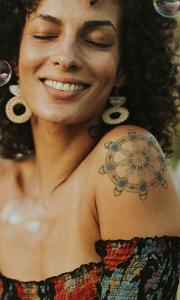 Tattooing has not always had a positive meaning. The use of tattoos to mark people out as slaves or criminals, in both Eastern and Western culture, led to some very negative associations. Sadly, in a very real sense, the tattoo became taboo.
Tattooing has not always had a positive meaning. The use of tattoos to mark people out as slaves or criminals, in both Eastern and Western culture, led to some very negative associations. Sadly, in a very real sense, the tattoo became taboo.
However, there’s been a strong drive to ‘reclaim’ the practice of tattooing.
Essentially, society has deemed tattooing to be a valuable part of our cultural heritage; an art form that has a unique ability to allow people to connect with their physical bodies and express themselves in a meaningful way.
People have always had an inherent understanding that the practice of body art, in tattooing, modification and beautification, is part of who we are. Despite negative associations being forced onto people by social norms which change through time, the truth – that tattooing is fundamentally important to human culture – was not going to be suppressed forever.
The use of tattooing as a fashion statement has let to some truly unfortunate body art, and we all know a few horror stories of regrettable tattoo decisions! However, we can also view this as evidence of the social and cultural acceptance of tattooing as a form of personal expression. Freedom to express ourselves in the way we choose to do it, is a positive and healthy thing, and body art can be an inspired way to do this.
Western culture now views the practice of tattooing as a deeply personal choice; we have moved past the era of judgement and now see tattoos as both a valuable insight into the person wearing them and a deeply personal experience for the wearer.
When we first see a tattoo, we appreciate it on an aesthetic level – how it looks, where it is positioned and what effect it has on us when we look at it. We then delve more deeply into the meaning behind the tattoo, the story it tells about the person and their inner life.
It is incredibly inspiring to note how modern tattoos reflect all of the ancient meanings; we use tattoos to record life events such as births and traumatic experiences, we create body art devoted to those we have loved and those we have lost, we use them to remind us of achievements and events, and most often, we use them to record and reinforce what we believe.

Your Personal Power Symbol is the numerology of your name & the astrology of your date of birth manifested as a unique symbol. It tells the story of your Soul’s journey. See how stunning your Power Symbol is at YourPersonalPowerSymbol.com
